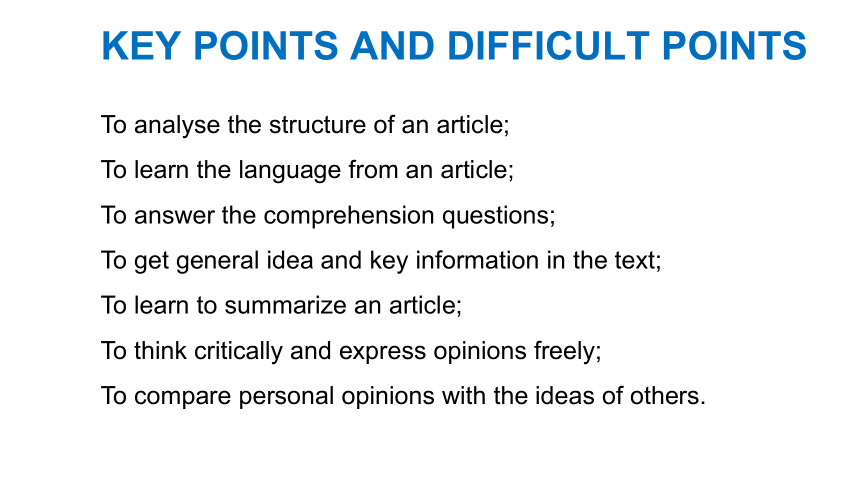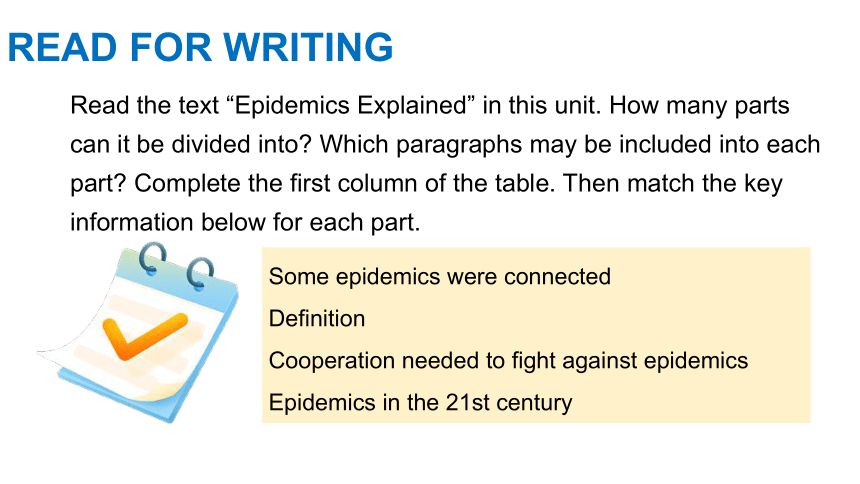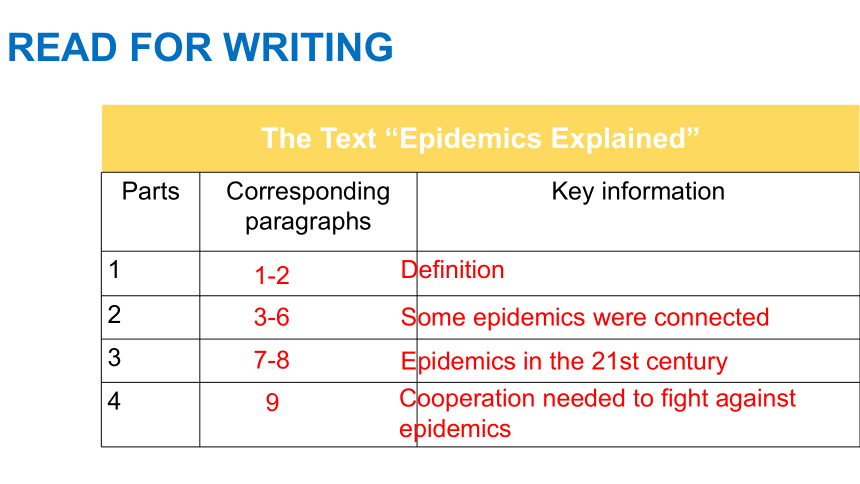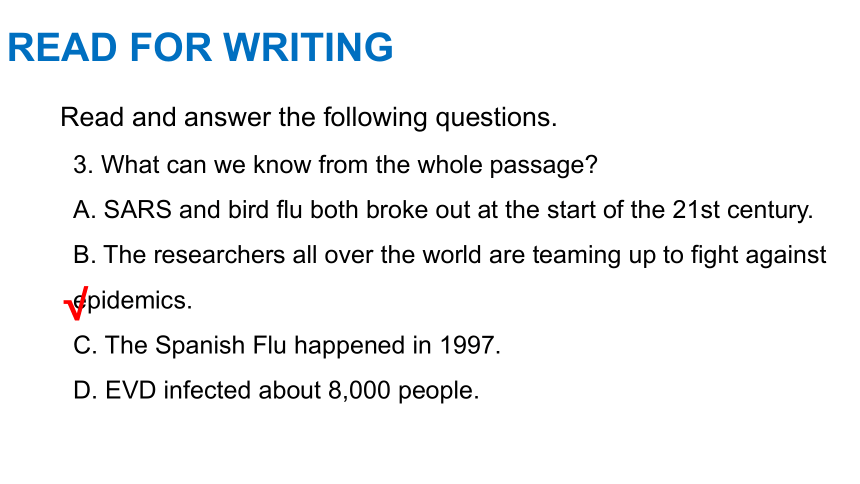UNIT 9 HUMAN BIOLOGY WRITING WORKSHOP课件1(共30张PPT,内镶嵌视频)-高中英语北师大版(2019)选择性必修第三册
文档属性
| 名称 | UNIT 9 HUMAN BIOLOGY WRITING WORKSHOP课件1(共30张PPT,内镶嵌视频)-高中英语北师大版(2019)选择性必修第三册 |  | |
| 格式 | pptx | ||
| 文件大小 | 9.6MB | ||
| 资源类型 | 教案 | ||
| 版本资源 | 北师大版(2019) | ||
| 科目 | 英语 | ||
| 更新时间 | 2025-04-03 22:15:08 | ||
图片预览












文档简介
WRITING WORKSHOP
UNIT 9 HUMAN BIOLOGY
LEARNING OBJECTIVES
To read and talk about articles about epidemics and cloning;
To analyse the structure and language of an article;
To summarise the main idea of a paragraph;
To read for general understanding;
To read for specific information and deep understanding;
To express personal opinions after reading an article;
To understand and learn words and expressions in context.
KEY POINTS AND DIFFICULT POINTS
To analyse the structure of an article;
To learn the language from an article;
To answer the comprehension questions;
To get general idea and key information in the text;
To learn to summarize an article;
To think critically and express opinions freely;
To compare personal opinions with the ideas of others.
LEADING IN
What is a summary?
A summary is a short overview of the main points of an article or other source, written entirely in your own words.
A summary is always much shorter than the original text. The length of a summary can range from just a few sentences to several paragraphs; it depends on the length of the article you’re summarizing, and on the purpose of the summary.
GET READY FOR WRITING
Pair Work You are going to write a summary for the text “To Clone or Not to Clone”. Put together some tips for writing a summary.
What do you do first?
What would you do next?
What advice would you give someone for writing a summary?
GET READY FOR WRITING
Pair Work You are going to write a summary for the text “To Clone or Not to Clone”. Put together some tips for writing a summary.
1. Read the original text.
2. Look for key details.
3. Write the summary.
4. Check the summary.
READ FOR WRITING
Read the text “Epidemics Explained” in this unit. How many parts can it be divided into? Which paragraphs may be included into each part? Complete the first column of the table. Then match the key information below for each part.
Some epidemics were connected
Definition
Cooperation needed to fight against epidemics
Epidemics in the 21st century
READ FOR WRITING
{5C22544A-7EE6-4342-B048-85BDC9FD1C3A}The Text “Epidemics Explained”
Parts
Corresponding paragraphs
Key information
1
2
3
4
1-2
Definition
3-6
Some epidemics were connected
7-8
Epidemics in the 21st century
9
Cooperation needed to fight against epidemics
READ FOR WRITING
Read and answer the following questions.
1. What can we know from the first paragraph?
A. An epidemic can spread rapidly.
B. An epidemic cannot be infected easily.
C. An epidemic can last only a short time.
D. An epidemic can’t cause too much loss.
√
READ FOR WRITING
Read and answer the following questions.
2. What can we know from professor Smith’s study?
A. He compared bird flu with The Black Death only.
B. He found the earliest epidemic was bird flu.
C. The Spanish Flu was considered the most severe epidemic.
D. The 1997 bird flu had nothing to do with the Great Flu of 1918.
√
READ FOR WRITING
Read and answer the following questions.
3. What can we know from the whole passage?
A. SARS and bird flu both broke out at the start of the 21st century.
B. The researchers all over the world are teaming up to fight against epidemics.
C. The Spanish Flu happened in 1997.
D. EVD infected about 8,000 people.
√
READ FOR WRITING
Pair Work Read the summary of “Epidemics Explained” below. Find the main focus for each paragraph. Compare the summary with the original text, what information is included and what is left out? Why? Share with your partner.
READ FOR WRITING
Pair Work Read the summary of “Epidemics Explained” below. Find the main focus for each paragraph. Compare the summary with the original text, what information is included and what is left out? Why? Share with your partner.
The key information is included and extra details such as the causes and classification of epidemics are left out.
READ FOR WRITING
An epidemic is the rapid spread of an infectious disease over a short period of time, causing a large number of deaths, the number of which differs for different diseases.
Professor Jim Smith conducted a study to compare the bird flu epidemic which occurred in 1997 with other deadly epidemics in our history. He found that the earliest epidemics took place as early as 500 to 550 CE, which killed half of the population in that particular area.
READ FOR WRITING
The same epidemic, called “The Black Death" returned in the 1330s in Asia and spread quickly to Europe. Some hundred years later, the Great Flu epidemic broke out in 1918, also known as the Spanish Flu, killing 50 million people. This was considered the most severe epidemic in human history. The 1997 bird flu which claimed over 100 lives was an adaptation of the Great Flu of 1918.
READ FOR WRITING
At the start of the 21st century, there were two major epidemics: SARS and EVD. The more recently discovered SARS disease infected about 8,000 people. According to
official records EVD has killed more than 11,310 people in West Africa alone.
Globally, researchers are coming together to try to identify the causes for epidemics and help to find effective treatments.
Read the text “To Clone or Not to Clone?”. How many parts can it be divided into? Which paragraphs may be included in each part? Find out the focus for each part. Complete the table.
FOCUS ON STRUCTURE AND LANGUAGE
{5C22544A-7EE6-4342-B048-85BDC9FD1C3A}The Text “To Clone or Not to Clone?”
Parts
Corresponding paragraphs
Main focuses
1
2
3
1
definition
2-3
successful examples on cloning
4-6
praises and concerns about cloning
Read the paragraph below. What’s the main idea of this paragraph? Underline the key words.
FOCUS ON STRUCTURE AND LANGUAGE
Cloning is the process of making an exact copy of a plant or animal and developing it either naturally or artificially. Natural cloning has been going on for generations. For example, gardeners have been using a form of cloning when they take a cutting from a plant and place it in a suitable medium, such as soil. Another example of natural cloning is identical twins, who are produced from the same egg.
Read the paragraph below. Summarise the paragraph in one sentence.
FOCUS ON STRUCTURE AND LANGUAGE
Cloning is the process of making an exact copy of a plant or animal and developing it either naturally or artificially. Natural cloning has been going on for generations. For example, gardeners have been using a form of cloning when they take a cutting from a plant and place it in a suitable medium, such as soil. Another example of natural cloning is identical twins, who are produced from the same egg.
Summary: Cloning means to make exact copy of a plant or animal and natural cloning has been going on for generations.
Do the same for the other parts of the text.
FOCUS ON STRUCTURE AND LANGUAGE
For years, there had been attempts to clone animals artificially. The first successfully cloned animal was a sheep named Dolly in 1996. At first, Dolly grew normally, but later she developed an illness ... After Dolly, scientists have cloned more than 20 mammal species, including ... However, they have found a similar pattern of health problems …
Summary: artificial cloning: cloned mammals
Do the same for the other parts of the text.
FOCUS ON STRUCTURE AND LANGUAGE
In January 2018, the cloning of two long-tailed monkeys, Zhong Zhong and Hua Hua, was announced by Chinese scientists. They were the first-ever primates … to have been cloned! In comparison with other species, cloning primates has proved to be “much harder” … Dr. Sun Qiang, director of the research team, said they had been wholly devoted to the research … The reason they worked so hard to break this technical barrier was …
Summary: artificial cloning: cloned primates
Do the same for the other parts of the text.
FOCUS ON STRUCTURE AND LANGUAGE
The successful cloning of primates has led to worldwide praise as a huge breakthrough that might lead to cures for various diseases and may also offer clues on how to prevent the aging process. With this technology, we have the potential to raise a large number of monkeys with identical genes ... This could help save research time …
Summary: the significance of cloning of primates
Do the same for the other parts of the text.
FOCUS ON STRUCTURE AND LANGUAGE
Cloning, however, continues to be an issue that causes a great deal of disagreement and provokes strong emotions. While some people believe it is crucial for scientific advancement, others raise moral concerns. They believe it is bound to lead to ... For example, they wonder if ... Furthermore, clones may ... Finally, they worry ...
Summary: moral concerns
Do the same for the other parts of the text.
FOCUS ON STRUCTURE AND LANGUAGE
So far, it is still unknown what will happen to Zhong Zhong and Hua Hua as they grow up. Researchers insist that the science of cloning should be further explored and advanced. As Einstein said, “Science is a powerful instrument ...”
Summary: conclusion
Complete the summary with the words and expressions you have learnt.
An epidemic is the rapid spread of an 1.___________ (infect) disease over a short period of time, 2.___________ (cause) a large number of deaths, the number of 3.___________ differs for different diseases.
Professor Jim Smith conducted a study to compare the bird flu epidemic 4.___________ other deadly epidemics in our history. He found that the 5.___________ (early) epidemics took
infectious
causing
which
with/to
earliest
PRACTICE
Complete the summary with the words and expressions you have learnt.
place as early as 500 to 550 CE and the same epidemic 6.___________ (call) “The Black Death” returned in the 1330s in Asia and spread to Europe quickly. Some hundred years later, the Great Flu epidemic broke out in 1918, which 7._____________________ (consider) the most severe epidemic in human history. The 1997 bird flu claiming over 100 lives was an 8.______________ (adapt) of the Great Flu of 1918.
called
was considered
adaptation
PRACTICE
Complete the summary with the words and expressions you have learnt.
SARS and EVD both broke out at the start of the 21st century. SARS infected about 8,000 people 9.____________ EVD killed more than 11,310 people in West Africa alone.
Fortunately, the researchers from all over the world are coming together to try to 10.___________ (identity) the causes for and help to find effective treatments for epidemics.
while/and
identify
PRACTICE
SUMMARY
Read and talk about articles about epidemics and cloning;
Analyse the structure and language of an article;
Analyze and summarise the main idea of a paragraph;
Get general understanding and specific information;
Learn about and practice words and expressions in context;
Think critically and express opinions freely;
Compare personal opinions with the ideas of others.
Thank you
UNIT 9 HUMAN BIOLOGY
LEARNING OBJECTIVES
To read and talk about articles about epidemics and cloning;
To analyse the structure and language of an article;
To summarise the main idea of a paragraph;
To read for general understanding;
To read for specific information and deep understanding;
To express personal opinions after reading an article;
To understand and learn words and expressions in context.
KEY POINTS AND DIFFICULT POINTS
To analyse the structure of an article;
To learn the language from an article;
To answer the comprehension questions;
To get general idea and key information in the text;
To learn to summarize an article;
To think critically and express opinions freely;
To compare personal opinions with the ideas of others.
LEADING IN
What is a summary?
A summary is a short overview of the main points of an article or other source, written entirely in your own words.
A summary is always much shorter than the original text. The length of a summary can range from just a few sentences to several paragraphs; it depends on the length of the article you’re summarizing, and on the purpose of the summary.
GET READY FOR WRITING
Pair Work You are going to write a summary for the text “To Clone or Not to Clone”. Put together some tips for writing a summary.
What do you do first?
What would you do next?
What advice would you give someone for writing a summary?
GET READY FOR WRITING
Pair Work You are going to write a summary for the text “To Clone or Not to Clone”. Put together some tips for writing a summary.
1. Read the original text.
2. Look for key details.
3. Write the summary.
4. Check the summary.
READ FOR WRITING
Read the text “Epidemics Explained” in this unit. How many parts can it be divided into? Which paragraphs may be included into each part? Complete the first column of the table. Then match the key information below for each part.
Some epidemics were connected
Definition
Cooperation needed to fight against epidemics
Epidemics in the 21st century
READ FOR WRITING
{5C22544A-7EE6-4342-B048-85BDC9FD1C3A}The Text “Epidemics Explained”
Parts
Corresponding paragraphs
Key information
1
2
3
4
1-2
Definition
3-6
Some epidemics were connected
7-8
Epidemics in the 21st century
9
Cooperation needed to fight against epidemics
READ FOR WRITING
Read and answer the following questions.
1. What can we know from the first paragraph?
A. An epidemic can spread rapidly.
B. An epidemic cannot be infected easily.
C. An epidemic can last only a short time.
D. An epidemic can’t cause too much loss.
√
READ FOR WRITING
Read and answer the following questions.
2. What can we know from professor Smith’s study?
A. He compared bird flu with The Black Death only.
B. He found the earliest epidemic was bird flu.
C. The Spanish Flu was considered the most severe epidemic.
D. The 1997 bird flu had nothing to do with the Great Flu of 1918.
√
READ FOR WRITING
Read and answer the following questions.
3. What can we know from the whole passage?
A. SARS and bird flu both broke out at the start of the 21st century.
B. The researchers all over the world are teaming up to fight against epidemics.
C. The Spanish Flu happened in 1997.
D. EVD infected about 8,000 people.
√
READ FOR WRITING
Pair Work Read the summary of “Epidemics Explained” below. Find the main focus for each paragraph. Compare the summary with the original text, what information is included and what is left out? Why? Share with your partner.
READ FOR WRITING
Pair Work Read the summary of “Epidemics Explained” below. Find the main focus for each paragraph. Compare the summary with the original text, what information is included and what is left out? Why? Share with your partner.
The key information is included and extra details such as the causes and classification of epidemics are left out.
READ FOR WRITING
An epidemic is the rapid spread of an infectious disease over a short period of time, causing a large number of deaths, the number of which differs for different diseases.
Professor Jim Smith conducted a study to compare the bird flu epidemic which occurred in 1997 with other deadly epidemics in our history. He found that the earliest epidemics took place as early as 500 to 550 CE, which killed half of the population in that particular area.
READ FOR WRITING
The same epidemic, called “The Black Death" returned in the 1330s in Asia and spread quickly to Europe. Some hundred years later, the Great Flu epidemic broke out in 1918, also known as the Spanish Flu, killing 50 million people. This was considered the most severe epidemic in human history. The 1997 bird flu which claimed over 100 lives was an adaptation of the Great Flu of 1918.
READ FOR WRITING
At the start of the 21st century, there were two major epidemics: SARS and EVD. The more recently discovered SARS disease infected about 8,000 people. According to
official records EVD has killed more than 11,310 people in West Africa alone.
Globally, researchers are coming together to try to identify the causes for epidemics and help to find effective treatments.
Read the text “To Clone or Not to Clone?”. How many parts can it be divided into? Which paragraphs may be included in each part? Find out the focus for each part. Complete the table.
FOCUS ON STRUCTURE AND LANGUAGE
{5C22544A-7EE6-4342-B048-85BDC9FD1C3A}The Text “To Clone or Not to Clone?”
Parts
Corresponding paragraphs
Main focuses
1
2
3
1
definition
2-3
successful examples on cloning
4-6
praises and concerns about cloning
Read the paragraph below. What’s the main idea of this paragraph? Underline the key words.
FOCUS ON STRUCTURE AND LANGUAGE
Cloning is the process of making an exact copy of a plant or animal and developing it either naturally or artificially. Natural cloning has been going on for generations. For example, gardeners have been using a form of cloning when they take a cutting from a plant and place it in a suitable medium, such as soil. Another example of natural cloning is identical twins, who are produced from the same egg.
Read the paragraph below. Summarise the paragraph in one sentence.
FOCUS ON STRUCTURE AND LANGUAGE
Cloning is the process of making an exact copy of a plant or animal and developing it either naturally or artificially. Natural cloning has been going on for generations. For example, gardeners have been using a form of cloning when they take a cutting from a plant and place it in a suitable medium, such as soil. Another example of natural cloning is identical twins, who are produced from the same egg.
Summary: Cloning means to make exact copy of a plant or animal and natural cloning has been going on for generations.
Do the same for the other parts of the text.
FOCUS ON STRUCTURE AND LANGUAGE
For years, there had been attempts to clone animals artificially. The first successfully cloned animal was a sheep named Dolly in 1996. At first, Dolly grew normally, but later she developed an illness ... After Dolly, scientists have cloned more than 20 mammal species, including ... However, they have found a similar pattern of health problems …
Summary: artificial cloning: cloned mammals
Do the same for the other parts of the text.
FOCUS ON STRUCTURE AND LANGUAGE
In January 2018, the cloning of two long-tailed monkeys, Zhong Zhong and Hua Hua, was announced by Chinese scientists. They were the first-ever primates … to have been cloned! In comparison with other species, cloning primates has proved to be “much harder” … Dr. Sun Qiang, director of the research team, said they had been wholly devoted to the research … The reason they worked so hard to break this technical barrier was …
Summary: artificial cloning: cloned primates
Do the same for the other parts of the text.
FOCUS ON STRUCTURE AND LANGUAGE
The successful cloning of primates has led to worldwide praise as a huge breakthrough that might lead to cures for various diseases and may also offer clues on how to prevent the aging process. With this technology, we have the potential to raise a large number of monkeys with identical genes ... This could help save research time …
Summary: the significance of cloning of primates
Do the same for the other parts of the text.
FOCUS ON STRUCTURE AND LANGUAGE
Cloning, however, continues to be an issue that causes a great deal of disagreement and provokes strong emotions. While some people believe it is crucial for scientific advancement, others raise moral concerns. They believe it is bound to lead to ... For example, they wonder if ... Furthermore, clones may ... Finally, they worry ...
Summary: moral concerns
Do the same for the other parts of the text.
FOCUS ON STRUCTURE AND LANGUAGE
So far, it is still unknown what will happen to Zhong Zhong and Hua Hua as they grow up. Researchers insist that the science of cloning should be further explored and advanced. As Einstein said, “Science is a powerful instrument ...”
Summary: conclusion
Complete the summary with the words and expressions you have learnt.
An epidemic is the rapid spread of an 1.___________ (infect) disease over a short period of time, 2.___________ (cause) a large number of deaths, the number of 3.___________ differs for different diseases.
Professor Jim Smith conducted a study to compare the bird flu epidemic 4.___________ other deadly epidemics in our history. He found that the 5.___________ (early) epidemics took
infectious
causing
which
with/to
earliest
PRACTICE
Complete the summary with the words and expressions you have learnt.
place as early as 500 to 550 CE and the same epidemic 6.___________ (call) “The Black Death” returned in the 1330s in Asia and spread to Europe quickly. Some hundred years later, the Great Flu epidemic broke out in 1918, which 7._____________________ (consider) the most severe epidemic in human history. The 1997 bird flu claiming over 100 lives was an 8.______________ (adapt) of the Great Flu of 1918.
called
was considered
adaptation
PRACTICE
Complete the summary with the words and expressions you have learnt.
SARS and EVD both broke out at the start of the 21st century. SARS infected about 8,000 people 9.____________ EVD killed more than 11,310 people in West Africa alone.
Fortunately, the researchers from all over the world are coming together to try to 10.___________ (identity) the causes for and help to find effective treatments for epidemics.
while/and
identify
PRACTICE
SUMMARY
Read and talk about articles about epidemics and cloning;
Analyse the structure and language of an article;
Analyze and summarise the main idea of a paragraph;
Get general understanding and specific information;
Learn about and practice words and expressions in context;
Think critically and express opinions freely;
Compare personal opinions with the ideas of others.
Thank you
